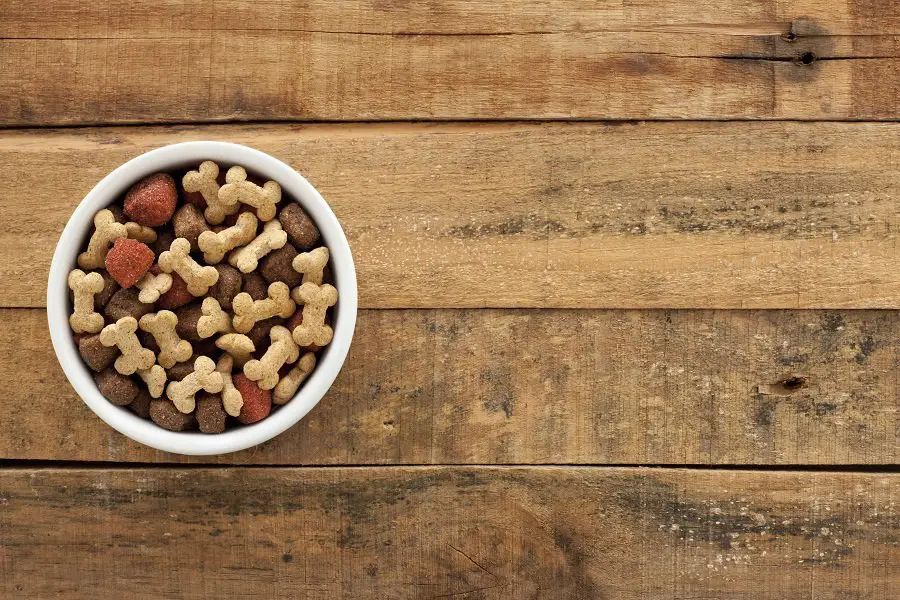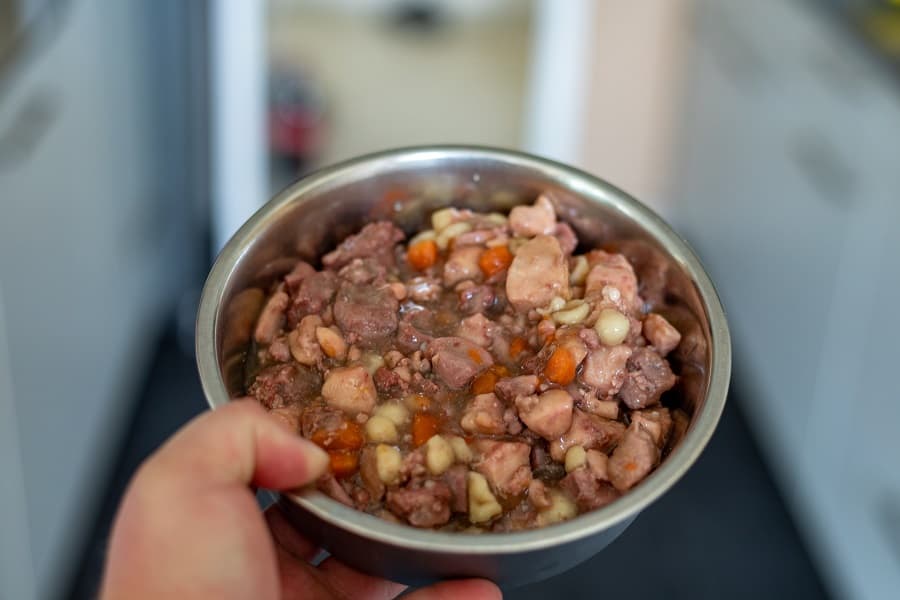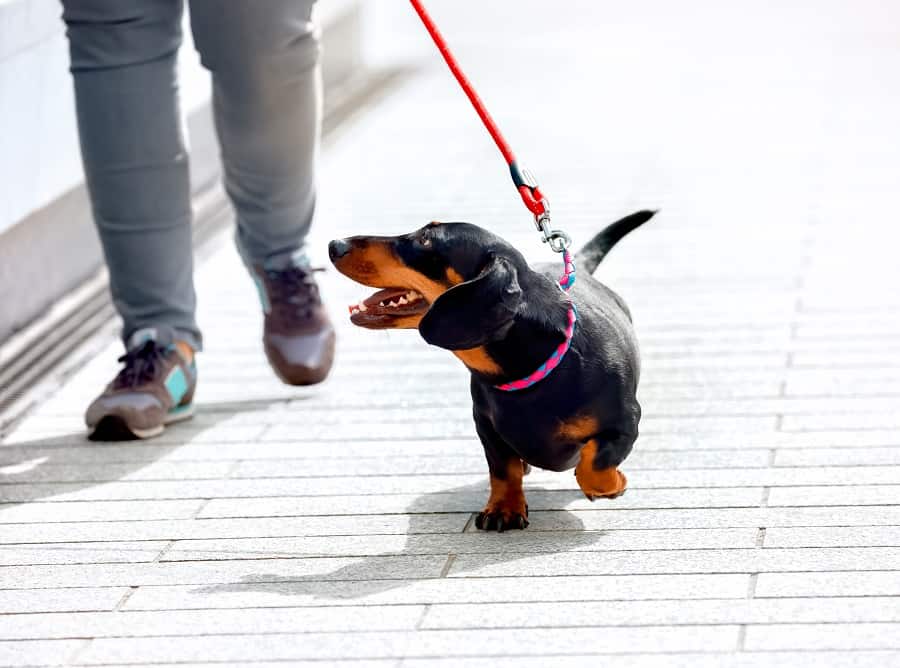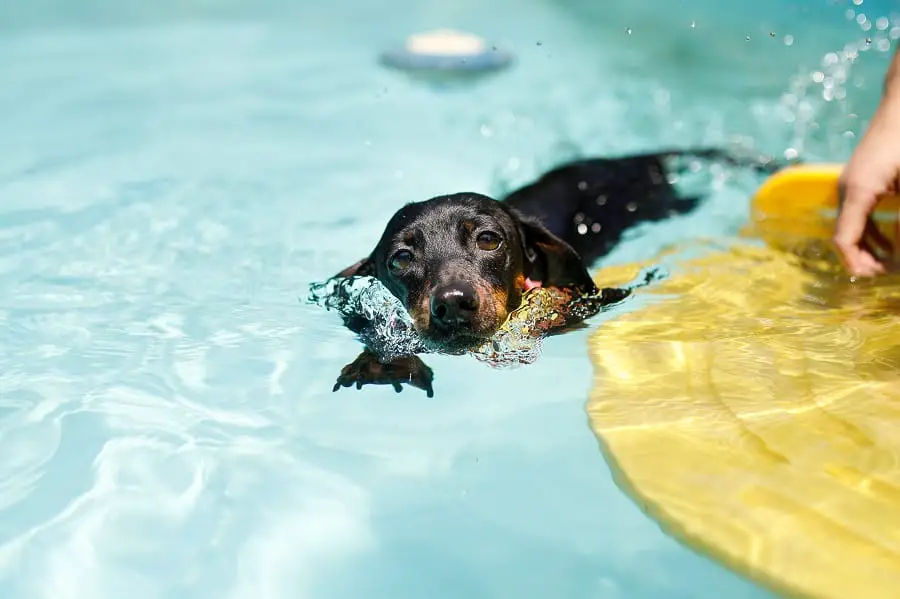An old Inuit proverb says: “Yesterday is ashes; tomorrow wood. Only today does the fire burn brightly.”
A fact of life is that it ends sooner or later; that’s as true for our doxies as it is for us.
One unknown day in the future we will take our last breath, and there’s no use in complaining about it when there’s so much living to do right now.

Dachshunds know this; living a long life is good, but being healthy while you’re living it is even better.
The average life expectancy of a dachshund is around 12 years, but many live for 17 years or more if they are not obese, have a nutritious diet, the right sort of exercise, and regular medical check-ups.
Below we’ll go into detail regarding these three pillars: Diet, Exercise and Veterinary Check-ups:
Diet
The many food options for dachshunds can sometimes be more confusing than helpful. Is kibble better than home cooking? What about raw food instead of canned food?
Basically, your dachshund’s meals should be mostly protein with some carbohydrates, a little fat, and minerals and vitamins.
Protein
Your dachshund must have a lot of protein to be healthy, energetic, repair muscles, form new skin cells and grow hair.
Protein should come from animals rather than plants because dachshunds don’t digest plant protein like lentils very well and it passes through their bodies without doing any good.

Meat, poultry, fish, and eggs are all excellent sources of protein, but don’t give your dachshund by-products of animal protein like bone, blood and feather meal – it’s not very nutritious, and you can’t know for sure what’s in it.
Protein must be part of a dachshund’s daily diet because the body doesn’t store it; the body uses what protein it needs, and the rest passes through the system.
For that reason, too much protein is not a problem because the excess will move through a dachshund’s system without causing any harm.
On the other hand, too little protein will make your dachshund weak and sluggish, and your dachshund will feel miserable.
At least 18% of your dachshund’s diet should be protein, and 50% would be better.
Carbohydrates
Some experts say that grain makes joint problems worse, while others claim your dachshund needs grain because it contains vitamins and minerals.
In general, carbs should be mostly cooked vegetables that can be easily digested and a small amount of fruit.
Healthy fruits and vegetables for dachshunds are apples, bananas, blueberries, brussels sprouts, cantaloupe, carrots, green beans, pumpkin, spinach, sweet potatoes, and watermelon.
If you want to include grain in your dachshund’s food, then a moderate amount of whole grain like wheat, brown rice, oatmeal, millet, and corn are all healthy choices.
Carbohydrates should not exceed 50% of a dachshund’s diet.
Fat
Dachshunds need the fat that has both Omega 3 and Omega 6 for healthy skins and coats. Fat is also necessary for brain and heart health.
Again, fat should come from animals like chicken fat or fish oil because the fat from plants, like flaxseed oil, is difficult for dachshunds to digest.
A dachshund’s diet should contain between 5% and 10% fat.
Vitamins and Minerals
If your doxie’s meals follow the protein, carbohydrate and fat guidelines above, they will also be getting the vitamins and minerals they need to live long and healthy lives.
If you’re worried that your dachshund isn’t getting the right food in the right amount, then a vitamin and mineral supplement may give you peace of mind.
However, it may be a good idea to ask your vet for professional advice because some experts believe that artificial minerals and vitamins don’t do any good at all, and others even believe they do harm.
Kibble
There are many brands of kibble: some make a kibble especially for dachshunds while others are grain free but have protein by-products.
Every brand advertises that their kibble is the healthiest and gives you the reasons why. So how do you decide which one is best for your dachshund?
You can ask your vet for advice, or you can read the labels.

If you’re going to read the labels, meat protein should be first on the list of ingredients, and it should be real meat like beef, pork, lamb, fish or poultry and not be a protein by-product.
Fruit and vegetables should be next on the label followed by grain if you’re okay with your dachshund having a little grain.
If you don’t want your doxie to have any grain at all, then you should choose a grain free kibble.
Check that the fat is from animals and not plants, and includes both Omega 3 and Omega 6.
Kibble packaging doesn’t always list vitamins and minerals so you may have to turn to the internet for additional information.
In any case, because kibble is cooked at very high temperatures the natural vitamins are depleted, and artificial vitamins and minerals added.
This is worrying for some dachshund owners because the manufacturers of these synthetic supplements may be a bit dodgy.
Don’t expect kibble to accurately follow the quantity guidelines of protein, carbohydrates, and fats; kibble is high in carbs because it has to be doughy to shape the pellets.
Nonetheless, it’s a popular choice for dachshund food because it’s very convenient.
Home cooked food
Delicious and nutritious. Your dachshund will be happy and healthy if you follow the protein, carbohydrate and fat content guidelines and are familiar with the foods that are healthy for your dachshund and the foods that aren’t.
If you jump into home-cooked meals without thoroughly educating yourself on the nutritional balance and daily calorie intake that your dachshund needs, you will be putting your doxie at risk.
The other obvious disadvantage of home cooked food is the time and effort required to prepare your dachshund’s meals.
It’s also unlikely that you will be able to cover all your dachshund’s nutritional requirements in one type of meal so you’ll be very busy preparing a variety of meals and snacks to cover all the bases.
Perhaps the most significant disadvantage of the home cooked diet is that it may not contain enough calcium which is essential for your dachshund, so be sure to give your dachshund yogurt (if your dachshund isn’t lactose intolerant) as well as fish like sardines and tuna as part of the meal or as a special treat.
There are hundreds of cooked food recipes on the internet, and your dachshund will never lack variety.
Your doxie will love home cooked meals, and you will love watching your dachshund enjoy them.
Canned food
Canned food tastes better than kibble and is more easily digestible, but dachshund owners have been known to have heated arguments about whether it’s healthy or not.
Some say that canned food is not as nutritious as kibble while others see it as a blessing for older dachshunds, or dachshunds that are recovering from an illness, or dachshunds who have missing teeth and find it hard to chew.

And there are even more who believe it is better than kibble because it’s high in protein and low in carbohydrates (it doesn’t need empty fillers like kibble does to make the dough).
Another advantage is that canned food doesn’t contain artificial preservatives because of the air-tight packaging.
Select a canned food that has real meat, poultry or fish and does not contain protein by-products.
Canned food that contains real meat, chicken or fish doesn’t need artificial flavoring or coloring but check the label to be sure; your dachshund doesn’t need them.
Kibble has some teeth cleaning advantages that canned food doesn’t, so if you do choose canned food over kibble, your dachshund may have to have professional teeth cleaning more often.
Raw food diet
The raw food diet for dogs hasn’t been around that long and is perhaps not gaining in popularity as a healthy choice.
The idea behind this diet is that before humans domesticated dogs, their wolf counterparts in the wild ate mainly raw meat and bones and that it’s therefore more natural for our pooches to do the same.
The problem with this theory is that doxies no longer resemble their wolf ancestors and eating raw meat, fish and poultry has severe risks.
Nonetheless, the raw food diet has many fans who believe that this way of eating will extend the lifespan of their dachshunds.
The benefits of the raw food diet are similar to the home cooked diet: you control what food you give your dachshund and where the ingredients come from, you can make meals specific to your dachshund’s needs, and there are no added preservatives.
Fans of the raw food diet believe that bones should be included and are good for your dachshund’s teeth.
But there is also a different opinion that bones are not good for your dachshund: they can damage and break teeth, and even more seriously, splinters can puncture the bowel which can be fatal.
The most serious risk of a raw food diet is the pathogens (bacteria and viruses) found in raw food which can cause any number of diseases and make your dachshund seriously ill or worse.
Also, it’s not easy for dachshunds to digest raw vegetables.
There isn’t a lot of scientific evidence that raw food is better for dachshunds than other diets, so it’s difficult to make this option an informed choice.
Foods to avoid
The list of foods that your doxie should not eat is a long one: chocolate, coffee, xylitol (found in sweets, peanut butter, and other processed foods), avocado, onions, salt, citrus, moldy foods (like blue cheese), grapes, and the list goes on and on.
Do some research if you’re the least bit doubtful about a particular food, and always check food labels for ingredients that may be toxic for dachshunds.
While some toxic foods result in treatable diarrhea and vomiting, others can cause liver failure, seizures, and even death.
Choosing the best option
Choosing the best food option for your dachshund, or a combination of food options will depend on your personal preference and lifestyle as well as your dachshund’s life stage.
Most dachshunds live to eat rather than the other way around, and it’s up to you to ensure the health and longevity of your doxie with nutritious and balanced food choices.
Exercise
Exercise is as important as diet for good health and extending the life expectancy of your doxie; it improves heart health, strengthens muscles to protect joints, and keeps your dachshund slim and trim.
Also, dachshunds have lots of energy, and if they don’t get enough exercise, you can expect lots of digging in the garden, shoe-chewing, barking, whining, and other destructive behavior.
Walking
Doxies love a walk; they’re inquisitive and intelligent and are truly happy to meet other dogs and their owners if they’ve been properly socialized.

Let your doxie stop to investigate smells and root about in shrubs and other foliage rather than hurrying them along; the mental stimulation of experiencing new things is as important to a dachshund as exercise.
A daily walk is healthy for you and your dachshund, costs nothing, and will save you expensive medical treatment in the long run.
Hunting Games
Dachshunds are never happier than when they’re hunting.
Hide their squeaky toys between the sofa cushions, under blankets, or in hard-to-get-at places in the garden, and your doxie will be getting exercise and mental stimulation for many happy hours.
A hike in the wild is like heaven on earth for dachshunds; if it can be done safely, let them off the lead and allow them to explore, chase and hunt.
Swimming
Dachshunds aren’t natural swimmers but can be taught with a little patience.

It’s excellent aerobic exercise, strengthens back muscles, eases arthritic joints, and is recommended therapy after back surgery. It’s also a refreshing alternative to a walk on a hot day.
Exercises to avoid
Our long-bodied, short-legged doxies are prone to disc problems, and they should never be allowed to climb up and down stairs or to jump on and off furniture.
Doggie ramps come in all shapes and sizes, and if they’re installed next to stairs, your bed, and the sofa, you’ll be saving your dachshund from expensive back surgery and a world of hurt.
Another option is to train your dachshund not to jump on furniture or to climb up and down stairs; instead, they should wait for you to carry or lift them.
If you do carry or lift your doxie, be sure to support both the front and rear end; don’t let your dachshund’s back legs dangle.
Some experts consider the chase and fetch game a safe exercise for dachshunds, while others do not because it requires a quick change of direction which twists the long back and puts a lot of pressure on the spine.
With other safe and fun exercises available, it may be a wise choice to avoid the fetch game.
Medical checkups
When our dachshund is a puppy we’re generally very good about visits to the vet for checkups, de-worming, and vaccinations, but later we often neglect this essential part of dachshund health.
An annual examination by a vet may detect a health problem that you haven’t noticed and early treatment can mean the difference between health and illness, even life and death.
As your dachshund reaches 8 or 9, your vet may suggest a twice-yearly checkup and do a geriatric screening which, in addition to a top-to-tail physical examination, includes blood tests, biochemistry profiles, and urinalysis.
Some vets may also use diagnostic imaging and ultrasound.
Make the time to take your doxie for regular checkups so that any problems can be diagnosed early and treated.
Obesity will shorten the life expectancy of your dachshund
Dachshunds love to eat and are prone to obesity.

Overweight dachshunds have a poor quality of life, and their life expectancy can be shortened by as much as two years.
Obesity can also lead to heart stress, diabetes, liver and kidney diseases, as well as joint and ligament damage.
The common ailments our doxies suffer from are weakened spines, knee caps that pop out of their groove, and hip deformities.
Early treatment is successful for all of these conditions, but they can also be entirely avoided if your dachshund is not overweight.
We all know that to lose weight one must eat fewer calories and use more.
Dachshunds love their food so decreasing the quantity of food is not a good option; instead, change to a scientifically formulated diet kibble which contains fewer calories but doesn’t leave your dachshund feeling hungry.
Be disciplined about measuring your dachshund’s food according to the instructions on the package.
Alternatively, bulk up your dachshund’s regular diet with low-calorie foods like cooked carrots and green beans and reduce the high-calorie foods like rice and kibble.
Develop good eating practices by feeding your dachshund twice a day at the same time and replace food treats with lots of cuddles and attention. Start a daily exercise program.
An obesity study found that more than 50% of dogs in North America are either overweight or obese; don’t let your dachshund be one of them.
Remember that food doesn’t replace love and never give up helping your doxie to shed those unhealthy kilos.
One last thought
“Dachshunds’ lives are too short. Their only fault, really.” Adapted from Agnes Sligh Turnbull.

